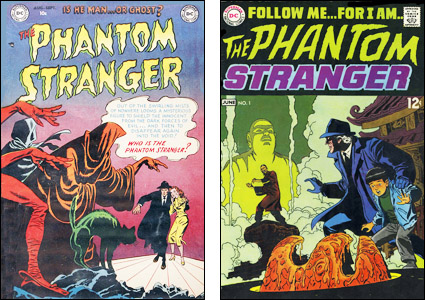Richard Baron wrote to ask me…
Carmine Infantino was the primary artist of the 1952 series for The Phantom Stranger. Based on a conversation I had once with Sy Barry, a major inker on the series, he had a special fondness for the character. Curiously, or not, shortly after Infantino moved into management, the character was given his own book. I don't think this was a coincidence. Do you know anything about this?
Not a coincidence in the slightest. Infantino was the first and main artist on the series which came out in '52 and lasted a mere six issues. It was a good comic but not a particularly unique one. Almost every company back then took a stab at some mysterious character in a big hat and cloak who was not unlike The Shadow, wandering about in spooky circumstances, making folks wonder if he was alive or a ghost or what.
In my opinion (for whatever's that worth) it was a pretty good comic. According to its editor, Julius Schwartz, he and Carmine (and others) were disappointed that the company gave up on it so quickly. It was a bi-monthly and as we've noticed elsewhere, back before the direct sales market emerged for comics, if a book lasted six bi-monthly issues, that meant the decision to cancel was probably made on early sales reports for #2.
I am not the only person who believes that this was a mistake that many comic book publishers in the past made way too often. They all probably talked at great length about trying to attract new readers to the newsstands but then expected those new readers to find a new comic immediately. It was like opening a new restaurant on Monday and deciding on Wednesday to go out of business because customers weren't flocking to your door. And I think DC really made this mistake a lot in the late sixties/early seventies after Infantino was put in command.

But he didn't make that mistake with the Phantom Stranger revival…and it's pretty obvious why Infantino and his crew decided to revive it in 1969. One was that Infantino and editor Joe Orlando had a belief that super-hero comics were cooling down and the next trend was "weird" comics — ghosts, demons, spirits, etc. Secondly, they both thought the character deserved another chance…
…and thirdly, they could judiciously use reprinted material from the first series to lower the cost of a new book. At about the same time, they took old stories from DC's defunct Dobie Gillis comic, did some retouch work and marketed a "new" comic of old material now called Windy & Willy. They also began cramming books like Strange Adventures and their romance titles with reprints, often altered to look less like reprints. This was when they paid bupkis (nothing) to the writers and artists whose work was reprinted.
Reprints in 32-page comics didn't sit well with readers of the day and most such attempts sold poorly…but the Phantom Stranger book swiftly shifted from partially-new to all-new and the new material was good enough to make the comic a modest hit — for a while. It ran seven years, making it one of the longer-running "new" comics of its day…lasting until (again, in my measly opinion) it had too many reprints stuffed into the package and too many miscast artists.
